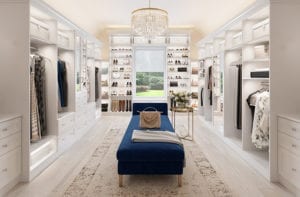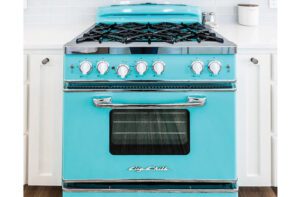Beauty and Brawn
January 12, 2015
Outdoorsy Adirondack style meets the modern preference for a light, airy feel in a northern Connecticut getaway.
Text by Charles Monagan Photography by John Gruen Produced by Karin Lidbeck Brent
The land fit the profile nearly perfectly: a rocky perch overlooking a pristine lake surrounded by a woodland of oak, laurel, and hemlock, with long western views to distant mountains and sunsets that would be spectacular across all four seasons. Here, in northwest Connecticut, was an ideal site on which to build a dream house from an earlier day—an Adirondack lodge inspired by the rustic retreats of the nineteenth century in nearby upstate New York.
The dream became reality following a series of well-choreographed steps. First, the owners worked with Reese Owens of Halper Owens Architects (now Reese Owens Architects) of Washington Depot to arrive at a singular design—a wondrous, open, inviting construct of timber and stone, airy in summer yet cozy in winter, with big visual thrills and numerous small pleasures. Next came the builder, Bob Nicholas of Robert Nicholas Construction in New Preston, and his crew. Their job was to dance on the head of a pin: to make this 5,000-square-foot, exquisitely detailed house unfold from its restricted footprint on a ledge bluff. Their assignments would include everything from digging five geothermal wells (for heating and cooling) beneath the house to carefully placing a 2,600-pound chimney cap at its very top. Finally, designer Karen Davis of Davis Raines Design, also in Washington Depot, was enlisted to help create the inner life of the new home. Her space plan and her decisions about palette, textiles, and other decorative elements would introduce a lighter, brighter tone—a contemporary note, but one that would harmonize with and buttress the classic Adirondack style.
Since the new house would be used largely for weekends, vacations, and special family gatherings, Owens and project architect Daniel Sullivan designed it to accommodate the leisure pursuits of the owners and their four children and to provide an overall sense of relaxation year-round.
Those involved in the project admire the design for both its functionality and beauty. “The house flows between the interior and the outdoors, linked by different porches from which you can walk down to the lake for a swim or snowshoe onto a nearby trail,” says Davis.
“Most impressive to me,” adds Nicholas, “is the massive nature of the stone and timber work, and the spectacular craftsmanship at work on the interiors.”
The drama begins at the front drive with the pleasing general lines of the house, its sides clad in wavy-edged western red cedar from British Columbia and its cascading rooflines finished off with evergreen architect-grade asphalt shingles. The entrance comes at the end of a series of stone steps, passing between sturdy, rustic oak railings, and then taking a 90-degree turn and another rise to the door. Each ascending step builds anticipation for what lofty views must be in store from the house and its several porches.
From the entry, where the homeowners can shake off their boots and let the bluestone surface warm their socks with radiant heat, the eye is drawn to the enormous central hearth of the great room, assembled in large part from native fieldstone. High above, a rail of decorative twig work crosses the room’s width and, higher still, diamond-shaped windows set between beams are lined with white birch bark. Along one wall, enormous windows help blur the line between outdoors and in, always a goal of the Adirondack style.
“Our clients were quite specific about the style, not meaning that they told us what to design or how to detail, but that it had to look and feel like a camp, or lodge,” says Owens. “The interior was to be all wood—walls and ceilings. It is a lot of fun for us when we have a client who is this engaged in the design process and appreciates what we do. As a result, we were able to design some special things like the log details, giant fireplace, white-birch decoration, peeled laurel frieze in the great room, butternut kitchen, ‘cabin’ walls in the children’s bedrooms, handmade cherry doors, and more.”
The clients’ dream was also carried out in the nterior design. “The seating, tables, and window treatments in the great room were custom-designed,” notes Davis. “I incorporated a customized tramp-art side table and hand-fired ceramic lamp, and also used the clients’ existing rug and the antique American flag. The idea here and in the other rooms was to create an uncluttered family space where they can host a large family dinner or retreat to a quiet space to read or work on puzzles, watch a movie, or play a game of Ping-Pong or pool.”
Throughout the house, the combination of various woods and stones, always in harmony, is a design key. Many materials came from the site or immediate surroundings, like the fieldstone, Mine Hill granite, wane-edge siding, laurel ornament, and the oak and eastern cedar timbers. Interior materials—the oak floors, pine and hemlock walls, cherry doors, and butternut cabinets—are predominantly clear-finished woods.
There is notable custom woodwork in the house as well. Thomas Sippel of Stick and Stone Studio, in Cummington, Massachusetts, provided the Native American–inspired cabinets and carvings, where the motifs, including artifacts from the owners’ collection, are especially attuned to the Mohawk people who once populated these hills. Sippel also crafted the sideboard in the dining area and the extraordinary dining table that playfully incorporates local animals into its design. The local fauna are seen elsewhere in the house, too, including the great room’s chandelier, made by architectural metalworker John Boyd Smith, on which beavers, bears, and a moose come to life as cutouts in the design.
“Overall, the space was meant to be light and airy,” says Davis. “While the architecture is classic Adirondack style, the accents and interior design capture a modern sensibility as well. The look is lightened with the modern kitchen and baths; the textiles are lighter and brighter than you found in the old lodges.”
Yet the house’s overall impression remains outdoorsy and quite muscular. “We were charged with creating something camp-like in spirit, ‘of the forest,’” says Owens, “with the meandering, built-over-time feel that characterizes the rustic style.”
Mission accomplished—with a home that seems the very definition of “relaxing in style.” •
Architecture: Reese Owens and Daniel Sullivan, Reese Owens Architects
Interior design: Karen Davis, Davis Raines Design
Builder: Bob Nicholas, Robert Nicholas Construction
Share
![NEH-Logo_Black[1] NEH-Logo_Black[1]](https://www.nehomemag.com/wp-content/uploads/2022/08/NEH-Logo_Black1-300x162.jpg)




















You must be logged in to post a comment.